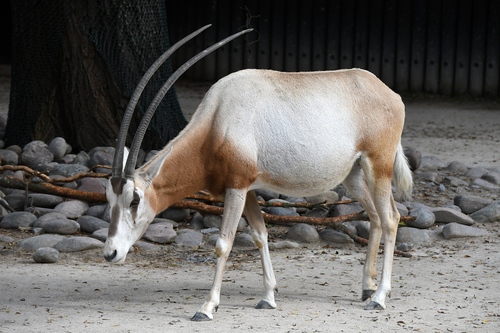
Scimitar-horned oryx
The Scimitar-horned oryx, with its distinctive curved horns and elegant white coat, stands as a desert survivor. Once roaming North Africa, it plays a crucial ecological role by grazing on tough desert vegetation, yet it remains critically endangered, symbolizing the delicate balance of desert ecosystems.
15-20 years
Lifespan
90.72 - 208.66 kg
Weight
Endangered
Conservation Status
Increasing
Population Trend
Characteristics
The Scimitar-horned oryx (Oryx dammah) is a striking antelope known for its long, curved horns and white coat with reddish-brown markings. Native to North Africa, it thrives in arid desert environments. This species is adapted to extreme heat and can go without water for long periods.
Distribution Range of the Scimitar-horned oryx
The Scimitar-horned Oryx (Oryx dammah) is native to North Africa. Historically, it was found across a broad range that included countries such as Egypt, Libya, Tunisia, Algeria, and Mauritania. The species is now considered extinct in the wild, but reintroduction efforts are underway in some regions, particularly in Chad and Niger.
Scimitar-horned oryx's Habitat
Environmental Conditions
The Scimitar-horned Oryx primarily inhabited arid and semi-arid environments, including deserts and dry steppe regions. These areas are characterized by extreme temperatures, low rainfall, and sparse vegetation. The oryx adapted to these harsh conditions with a physiology suited for long periods without water.
Ecological Niche
In its natural habitat, the Scimitar-horned Oryx played a role as a grazer, feeding on grasses, herbs, and shrubs. Its ability to survive in extreme heat and arid conditions allowed it to occupy niches that many other herbivores could not, providing a unique contribution to the desert ecosystem. The species also exhibited migratory behavior, moving across large distances in search of food and water.
Copyright @ Nature Style Limited. All Rights Reserved.
 English
English